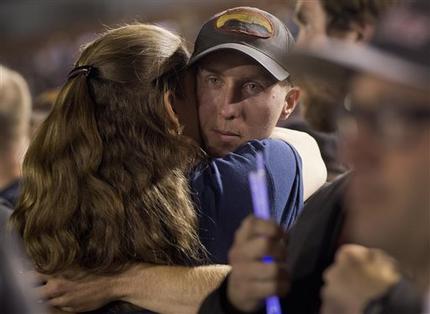PRESCOTT, Ariz. (AP) — Three days after 19 firefighters perished in a wildfire, questions over what exactly went wrong loomed largest.

Investigators from across the U.S. will be working this week to try to answer that, examining radio logs, the site of the tragedy and weather reports. They’ll also surely be talking to the sole survivor of the blaze, who warned his fellow firefighters and friends when he saw the wildfire switch directions and head straight for them.
In the nation’s biggest loss of firefighters since 9/11, violent wind gusts on Sunday turned what was believed to be a relatively manageable lightning-ignited forest fire in the town of Yarnell into a death trap that left no escape for the team of Hotshots, most of them in the prime of their lives.
Nearly 600 firefighters are battling the mountain blaze, which had burned about 13 square miles and destroyed an estimated 50 homes in Yarnell, a town of about 700 people. Hundreds were evacuated.
Fire spokeswoman Paige Rockett said the forecast calls for lighter wind Wednesday but noted that drought conditions still make it a dangerous situation. The hope is to allow residents back into their homes over the weekend and contain the fire by July 12. It remained 8 percent contained Wednesday.
Only one member of the crew, identified Tuesday as 21-year-old Brendan McDonough, survived. He was on a hilltop serving as a lookout and warned his crew that the weather was changing rapidly, and that the fire had changed directions because of strong, erratic winds. McDonough made it to safety, while the rest were overtaken by the blaze.
“He did exactly what he was supposed to,” said Wade Ward, who implored the media to respect McDonough’s privacy as he and the families mourn. “He’s trying to deal with the same things that we’re all trying to deal with, but you can understand how that’s compounded being there on the scene.”
McDonough grieved with families of the fallen firefighters Tuesday evening at a public memorial service in Prescott. More than 3,000 people gathered at a high school football stadium to remember the 19 men during a service punctuated by repeated moments of silence amid emotional remarks from pastors and officials.
“On behalf of the Prescott Fire Department, I want to thank all of you,” said Ralph Lucas, a battalion chief for the Prescott Fire Department. “This has brought us to our knees but at some point there will be another house fire or wildfire.”
After one moment of silence, 19 purple balloons – one for each of the fallen firefighters – were released into the air.
McDonough and victims’ families sat in a special seating area in the stadium that was roped off. He was not accessible to reporters and security escorted him and the others out of the venue when the event ended.
The service marked the first opportunity for many in the Prescott community to gather together since 19 of the men fighting a fire in nearby Yarnell died in the line of duty.
“We’re just here to share energy with our community,” said Andrew Secundy, a Wells Fargo financial manager who couldn’t attend an afternoon memorial the previous day because of work.
The nine-member team of investigators, comprised of forest managers and safety experts who arrived in Arizona on Tuesday, is expected to release an update later this week.
The ultimate goal: Prevent a similar thing from happening again.
“We have a responsibility to those lost and their loved ones, as well as to current and future wildland firefighters, to understand what happened as completely as possible,” Arizona State Forester Scott Hunt said in a statement.
Safety standards for wildland firefighters were toughened nearly 20 years ago when 14 firefighters died on Colorado’s Storm King Mountain, and investigators found a number of errors in the way the blaze was fought.
In what fire authorities said was an eerily similar situation to the Arizona blaze, a rapid change in weather sent winds raging on Storm King Mountain in Colorado, creating 100-foot flames. Firefighters were unable to escape, as a wall of fire raced up a hillside.
Essentially, it was “mass entrapment of an entire Hotshot crew,” said Lloyd Burton, professor of environmental law and policy at the University of Colorado.
“There are so many striking parallels between this tragedy and what happened on Storm King in 1994, it’s almost haunting,” he said.
Those changes included policies that say no firefighters should be deployed unless they have a safe place to retreat. They must also be continuously informed of changing weather and post lookouts.
Sunday’s tragedy raised questions of whether the Hotshot crew should have been pulled out much earlier and whether all the usual precautions would have made any difference at all in the face of triple-digit temperatures, erratic winds and tinderbox conditions that caused the fire to explode.
Dick Mangan, a retired U.S. Forest Service safety official and consultant, said the crew members might have taken too many risks because they were on familiar ground and were trying to protect a community they knew well.
“They don’t want to see a community burn down,” Mangan said. “They want to get in there.”
With the investigation just beginning, it’s not clear what help water- or retardant-dropping aircraft could have provided for the doomed crew.
One contractor, Neptune Aviation Services, had three aerial tankers making drops on the fire earlier in the day. But at the time the firefighters died, the planes had been grounded because of treacherous conditions, said chief executive Ronald Hooper.
“It wasn’t safe for them to be in the air at that time,” Hooper said. There were “severe winds, erratic winds and thunderstorms in the area.”
However, government dispatch logs show at least two other planes were flying over the fire at the time, one large tanker and one small one. There was also at least one firefighting helicopter in the air early Sunday afternoon.





